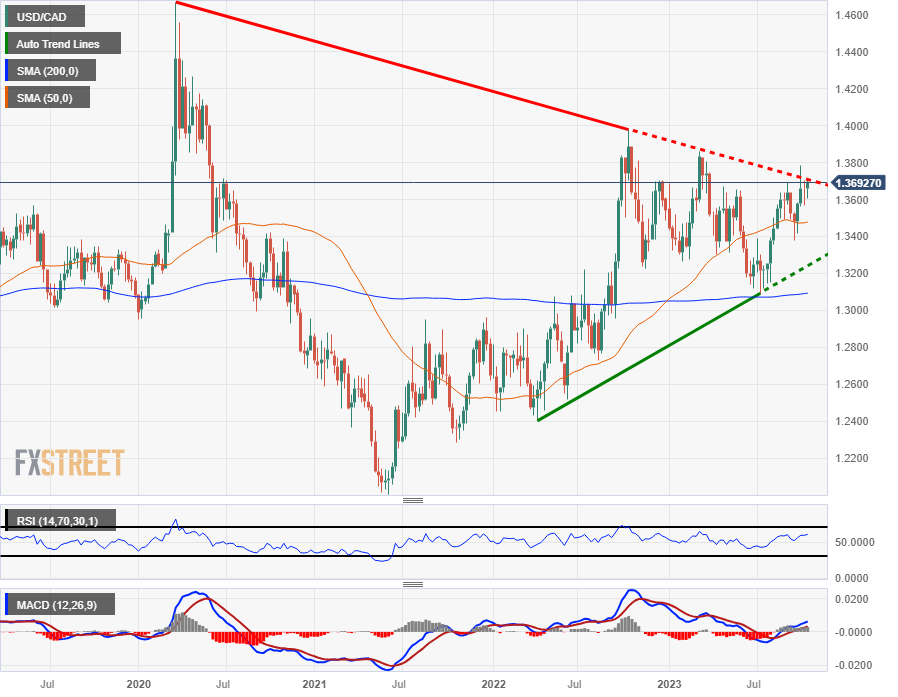- The Canadian dollar falls back to known lows on Wednesday, as investors withdraw their bets.
- Housing starts data in Canada was better than expected, but risk-averse flows are dominating.
- Thin agenda for CAD until Friday’s retail sales.
He Canadian dollar (CAD) is retreating in the American market session as risk appetite has turned south, sending investors back to the US dollar (USD) and leading to USD/CAD back to the graphics.
Housing starts in Canada managed to come out better than expected, while US housing data was mixed, but overall market sentiment has turned risk-off by mid-week, and the US Dollar The US is rising across the board, sending the CAD lower in parallel with crude oil prices declining again in the day’s opening bids.
Daily summary of market movements: Canadian dollar reverses course in the middle of the day, while risk appetite turns against
- Housing starts in Canada exceeded expectations, showing 270,500 additional homes built during the year to September.
- The data easily surpassed forecasts of 240,000 and surpassed the last reading of 250,400 (revised downward from 253,000).
- US housing data showed mixed results: building permits exceeded expectations, while housing starts derailed forecasts.
- The US granted 1.475 million new construction permits in September, just above forecasts of 1.45 million, but down from 1.541 million in August (revised downward from 1.543 million).
- US housing construction disappointed markets, with 1.358 million homes or apartments under construction in September, less than the 1.38 million expected, but an improvement from 1.269 million in August (revised downward from 1.283 million ).
- Initial jobless claims in the United States will be published on Thursday, as well as a series of speeches by Federal Reserve (Fed) officials, including that of Fed Chairman Jerome Powell, tomorrow at 16:00 GMT .
- Crude oil was bid up during the early hours of the session on Wednesday, but in the US market window investors are having second thoughts, and oil prices are falling back to square one.
- Global geopolitical tensions due to the conflict between Israel and Hamas continue to weigh on investors’ risk appetite.
- The US is also suffering from its own political uncertainty, as the US government struggles to replace its Speaker of the House of Representatives, who was ousted by his own party.
- US Treasury yields have hit another high, with the US 10-year yield at its highest yield in seventeen years near 4.92%.
Technical Analysis: The Canadian Dollar declines as investors bet on the Dollar again.
The USD/CAD pair is breaking above the 1.3700 area on Wednesday, and is testing the high prices of recent weeks. The pair has been in a huge range for an entire year, oscillating between highs just below 1.4000 and lows at 1.3150. Now it is approaching the maximums of the range again.
In fact, the pair is struggling with a main trend line around 1.3685, drawn connecting the October 2022 and March 2023 highs, and is likely to present stiff resistance above. The ideal would be a decisive break to definitively put this ceiling in the rearview mirror.
Such a breakout would be characterized by a longer-than-normal green weekly candle that cleanly broke the resistance line, or three successive green weekly bars.
Despite the main sideways trend, the intermediate and short-term trends are more bullish, suggesting that the longs have their backs to the wind. If it weren’t for the main resistance line, there would be a green light indicating “go”, but it could be an obstacle.
USD/CAD Weekly Chart
Canadian Dollar FAQ
What are the key factors driving the Canadian dollar?
The key factors driving the Canadian Dollar (CAD) are the level of interest rates set by the Bank of Canada (BoC), the price of oil, Canada’s largest export, the health of its economy, inflation and Trade balance, which is the difference between the value of Canada’s exports versus its imports. Other factors are market sentiment, that is, whether investors are betting on riskier assets (risk appetite) or looking for safe havens (risk aversion), with risk appetite being positive for the CAD. As a major trading partner, the health of the US economy is also a key factor influencing the Canadian dollar.
How do the decisions of the Bank of Canada influence the Canadian dollar?
The Bank of Canada (BoC) significantly influences the Canadian dollar by setting the level of interest rates that banks can lend to each other. This influences the level of interest rates for everyone. The BOC’s main objective is to keep inflation between 1% and 3% by adjusting interest rates up or down. Relatively higher interest rates are usually positive for the CAD. The Bank of Canada can also use quantitative easing and tightening to influence credit conditions, with the first being negative for the CAD and the second being positive for the CAD.
How does the price of oil influence the Canadian dollar?
The price of oil is a key factor influencing the value of the Canadian Dollar. Oil is Canada’s largest export, so the price of oil tends to have an immediate impact on the value of the CAD. Generally, if the price of oil rises, the CAD also rises, as aggregate demand for the currency increases. The opposite occurs if the price of oil falls. Higher oil prices also tend to result in a higher probability of a positive trade balance, which is also support for the CAD.
How does inflation data influence the value of the Canadian Dollar?
Although inflation has traditionally always been considered a negative factor for a currency, reducing the value of money, the opposite has actually happened in modern times, with the relaxation of cross-border capital controls. Inflation tends to lead central banks to raise interest rates, which attracts more capital from investors around the world looking for a lucrative place to store their money. This increases the demand for the local currency, which in the case of Canada is the Canadian Dollar.
How does economic data influence the value of the Canadian dollar?
Macroeconomic data releases measure the health of the economy and can influence the Canadian dollar. Indicators such as GDP, manufacturing and services PMIs, employment and consumer sentiment surveys can influence the direction of the CAD. A strong economy is good for the Canadian dollar. Not only does it attract more foreign investment, but it may encourage the Bank of Canada to raise interest rates, resulting in a stronger currency. However, if economic data is weak, the CAD is likely to fall.
Source: Fx Street
I am Joshua Winder, a senior-level journalist and editor at World Stock Market. I specialize in covering news related to the stock market and economic trends. With more than 8 years of experience in this field, I have become an expert in financial reporting.








